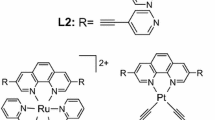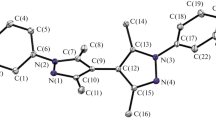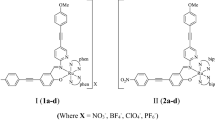Abstract
A series of dinuclear Ru(ii) polypyridine complexes have been prepared and their absorption spectra and luminescence properties (both at room temperature in acetonitrile fluid solution and at 77 K in butyronitrile rigid matrix) have been investigated. The species studied are [(bpy)2Ru(L1)Ru(bpy)2]4+ (1; bpy = 2,2′-bipyridine), [(tpy)Ru(Ln)Ru(tpy)]4+ (2, Ln = L2; 3, Ln = L3; 4, Ln = L4; tpy = 2,2′:6′,2″-terpyridine; for L1–L4 bridging ligands, see Fig. 1). All the compounds exhibit intense absorption bands in the UV region, assigned to spin-allowed ligand-centered (LC) transitions, and moderately intense spin-allowed metal-to-ligand charge-transfer (MLCT) absorption bands in the visible. The compounds also exhibit relatively intense emissions, originating from triplet MLCT levels, both at 77 K and at room temperature. All the new compounds contain a free chelating bipyridine site within their bridging ligand structure, and this confers to the new species interesting properties as far as the effect of perturbation (e.g., addition of acid or zinc salts) on the absorption and luminescence properties is concerned. Indeed, the luminescence intensity of each species is strongly affected by the presence of protons or cations. In particular, upon acid or zinc salts addition the luminescence intensity of 1 decreases, while the luminescence intensity of 2–4 increases. This different behaviour is related to the different dominating pathways for MLCT excited-state decay in Ru(ii) chromophores containing tridentate or bidentate polypyridine ligands. The redox behavior of 1 and 2 has also been investigated in acetonitrile solution in the absence and presence of zinc salts. It has been found that the electronic interaction between the peripheral chromophores is enhanced by zinc coordination.
Similar content being viewed by others
References and notes
J.-P. Sauvage, J.-P. Collin, J.-C. Chambron, S. Guillerez, C. Coudret, V. Balzani, F. Barigelletti, L. De Cola, L. Flamigni, Ruthenium(ii) and osmium(ii) bis(terpyridine) complexes in covalently-linked multicomponent systems: synthesis, electrochemical behavior, absorption spectra, photochemical and photophysical properties, Chem. Rev., 1994, 94, 993
V. Balzani, A. Juris, M. Venturi, S. Campagna, S. Serroni, Luminescent and redox-active polynuclear transition-metal complexes, Chem. Rev., 1996, 96, 759
C. A. Bignozzi, J. R. Schoonover, F. Scandola, A supramolecular approach to light harvesting and sensitization of wide-bandgap semiconductors: antenna effects and charge separation, Prog. Inorg. Chem., 1997, 44, 1
P. Belser, S. Bernhard, C. Blum, A. Beyeler, L. De Cola, V. Balzani, Molecular architecture in the field of photonic devices, Coord. Chem. Rev., 1999, 192, 155.
V. Balzani, S. Campagna, G. Denti, A. Juris, S. Serroni, M. Venturi, Designing dendrimers based on transition-metal complexes. Light harvesting properties and predetermined redox patterns, Acc. Chem. Res., 1998, 31, 26
L. Sun, L. Hammarström, B. Akermark, S. Styring, Towards artificial photosynthesis: ruthenium-manganese chemistry for energy production, Chem. Soc. Rev., 2001, 30, 36
F. Barigelletti, L. Flamigni, Photoactive molecular wires based on metal complexes, Chem. Soc. Rev., 2000, 29, 1.
R. Ballardini, V. Balzani, A. Credi, M. T. Gandolfi, M. Venturi, Artificial molecular-level machines: which energy to make them work?, Acc. Chem. Res., 2001, 34, 445
D. Pomeranc, V. Heitz, J.-C. Chambron, J.-P. Sauvage, Octahedral Fe(ii) and Ru(ii) complexes based on a new bis 1,10-phenanthroline ligand that imposes a well defined axis, J. Am. Chem. Soc., 2001, 123, 12215
C. N. Fleming, K. A. Maxwell, J. M. De Simone, T. J. Meyer, J. M. Papanikolas, Ultrafast excited-state energy migration dynamics in an efficient light-harvesting antenna polymer based on Ru(ii) and Os(ii) polypyridyl complexes, J. Am. Chem. Soc., 2001, 123, 10336
H. Berglund Baudin, J. Davidsson, S. Serroni, A. Juris, V. Balzani, S. Campagna, L. Hammarström, Ultrafast energy transfer in binuclear ruthenium–osmium complexes as models for light-harvesting antennas, J. Phys. Chem. A, 2002, 106, 4312.
S. Serroni, S. Campagna, F. Puntoriero, C. Di Pietro, F. Loiseau, N. D. McClenaghan, Dendrimers based on ruthenium(ii) and osmium(ii) polypyridine complexes and the approach of using complexes as ligands and complexes as metals, Chem. Soc. Rev., 2001, 30, 367.
J. N. Demas, G. A. Crosby, Measurement of photoluminescence quantum yields. A review, J. Phys. Chem., 1971, 75, 991.
N. Nakamaru, Photophysical properties of ruthenium(ii) polypyridine complexes, Bull. Chem. Soc. Jpn., 1982, 55, 2697.
S. Campagna, G. Denti, S. Serroni, A. Juris, M. Venturi, V. Ricevuto, V. Balzani, Dendrimers of nanometer size based on metal complexes. Luminescent and redox-active polynuclear metal complexes containing up to 22 metal centers, Chem. Eur. J., 1995, 1, 211.
K. O. Johansson, J. A. Lotoski, C. C. Tong, G. S. Hanan, Toward high nuclearity ruthenium complexes: creating new binding sites in metal complexes, Chem. Commun., 2000, 819.
A. Juris, V. Balzani, F. Barigelletti, S. Campagna, P. Belser, A. von Zelewsky, Ruthenium(ii) polypiridine complexes: photophysics, photochemistry, electrochemistry, and chemiluminescence, Coord. Chem. Rev., 1985, 84, 85 and references therein.
T. J. Meyer, Photochemistry of MLCT excited states, Pure Appl. Chem., 1986, 58, 1193 and references therein.
M. Maestri, N. Armaroli, V. Balzani, E. C. Constable, A. M. W. Cargill Thompson, Complexes of the Ruthenium(ii)-2,2′:6′,2″-terpyridine family. Effect of electron-accepting and -donating substituents on the photophysical and electrochemical properties, Inorg. Chem., 1995, 34, 2759
P. Ceroni, A. Credi, V. Balzani, S. Campagna, G. S. Hanan, C. R. Arana, J.-M. Lehn, Absorption and emission properties of di- and trinuclear ruthenium(ii) rack-type complexes, Eur. J. Inorg. Chem., 1999, 1409.
A. El-ghayoury, A. Harriman, A. Khatyr, R. Ziessel, An unusually shallow distance-dependence for triplet-energy transfer, Angew. Chem. Int. Ed., 2000, 39, 185
Y. Fang, N. J. Taylor, G. S. Hanan, F. Loiseau, R. Passalacqua, S. Campagna, H. Nierengarten, A. Van Doersselaer, A strategy for improving the room temperature luminescence properties of Ru(ii) complexes with tridentate ligands, J. Am. Chem. Soc., 2002, 124, 7912.
A. Mamo, I. Stefio, M. F. Parisi, A. Credi, M. Venturi, C. Di Pietro, S. Campagna, Luminescent and redox-active iridium(iii)-cyclometalated compounds with terdentate ligands, Inorg. Chem., 1997, 36, 5947.
C. Di Pietro, S. Serroni, S. Campagna, M. T. Gandolfi, R. Ballardini, S. Fanni, W. Browne, J. G. Vos, Proton controlled intramolecular communication in dinuclear ruthenium(ii) polypyridine complexes, Inorg. Chem., 2002, 41, 2871.
C. Chiorboli, C. A. Bignozzi, F. Scandola, E. Ishow, A. Gourdon, J.-P. Launay, Photophysics of dinuclear Ru(ii) and Os(ii) complexes based on the tetrapyrido[3,2-a:2′,3′-c:3″,2″-h:2′″-3′″-j]phenazine (tpphz) bridging ligand, Inorg. Chem., 1999, 38, 2402
S. Campagna, S. Serroni, S. Bodige, F. M. MacDonnell, Absorption spectra, photophysical properties, and redox behavior of stereochemically pure dendritic ruthenium(ii) tetramers and related dinuclear and mononuclear complexes, Inorg. Chem., 1999, 38, 692
E. J. C. Olson, D. Hu, A. Hörmann, A. M. Jonkman, M. R. Arkin, A. D. A. Stemp, J. K. Barton, P. F. Barbara, First observation of the key intermediate in the “Light-Switch” mechanism of [Ru(phen)2dppz]2+, J. Am. Chem. Soc., 1997, 119, 11458.
S. Fanni, C. Di Pietro, S. Serroni, S. Campagna, J. G. Vos, Ni(0) catalysed homo-coupling reactions: a novel route towards the synthesis of multinuclear ruthenium polypyridine complexes featuring made-to-order properties, Inorg. Chem. Commun., 2000, 3, 42.
G. Giuffrida, S. Campagna, Influence of the peripheral ligands on the metal–metal interaction in dinuclear metal complexes with N-heterocyclic bridging ligands, Coord. Chem. Rev., 1994, 135–136, 517 and references therein.
Y. Ohsawa, M. K. De Armond, K. W. Hanck, D. E. Morris, D. G. Whitten, P. E. Neveux, Spatially isolated redox orbitals: evidence from low-temperature voltammetry, J. Am. Chem. Soc., 1983, 105, 6522.
Y. Kawanishi, N. Kitamura, Y. Kim, S. Tazuke, Photochemistry of Ru(ii) complexes with polypyridine ligands, Sci. Pap. Inst. Phys. Chem. Res. (Riken Q.), 1984, 78, 212.
Author information
Authors and Affiliations
Corresponding authors
Rights and permissions
About this article
Cite this article
Loiseau, F., Passalacqua, R., Campagna, S. et al. New dinuclear Ru(ii) complexes containing free chelating polypyridine sites within the bridging ligands: absorption spectra, luminescence properties, redox behavior and sensing properties. Photochem Photobiol Sci 1, 982–990 (2002). https://doi.org/10.1039/b206362j
Received:
Accepted:
Published:
Issue Date:
DOI: https://doi.org/10.1039/b206362j




